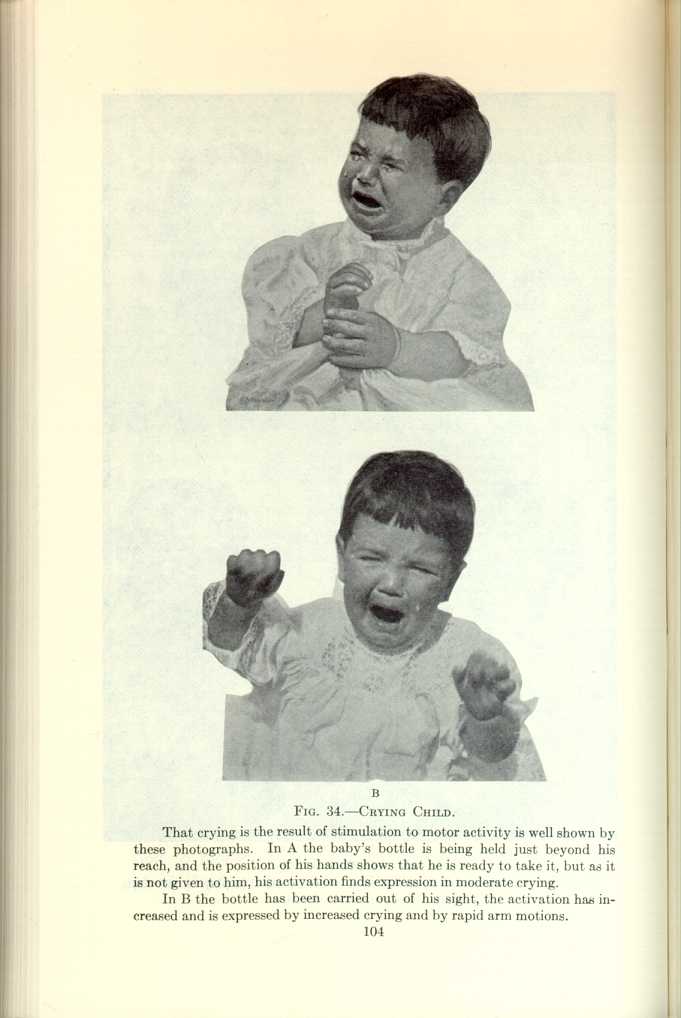| The Origin and Nature of the Emotions: Miscellaneous Papers | ||
PAIN, LAUGHTER, AND CRYING[1]
PAIN
Pain, like other phenomena, was probably evolved for a particular purpose—surely for the good of the individual; like fear and worry, it frequently is injurious. What then may be its purpose?
We postulate that pain is one of the phenomena which result from a stimulation to motor action. When a barefoot boy steps on a sharp stone it is important that the injuring contact be released as quickly as possible; and therefore physical injury pain results and impels the required action. Anemia of the soft parts at the points of pressure results from prolonged sitting or lying in one position, and as a result pain compels a muscular action that shifts the damaging pressure—this is the pain of anemia; when the rays of the blazing sun shine directly upon the retina, pain immediately causes a protective muscular action—the lid is closed, the head turns away—this is light pain; when standing too close to a blazing fire the excessive heat causes a pain which results in the protective muscular action of moving away—this is heat pain; when the urinary bladder is acutely overdistended the resultant pain induces voluntary as well as involuntary muscular contraction—this is evacuation pain; associated with defecation is a characteristic warning pain, and an active pain which induces the required muscular action—this, like the pain accompanying
Let us pass on to the discussion of another and perhaps even more interesting type of pain, that associated with infection. Not all kinds of infection are painful; and in those infections that may be associated with pain there is pain only when certain regions of the body are involved. Among the infections that are not associated with pain are scarlet fever, typhoid fever, measles, malaria, whooping-cough, typhus fever, and syphilis in its early stages. The infections that are usually, though not always, associated with pain are the pyogenic infections. The pyogenic infections and the exanthemata constitute the great majority of infections and are the basis of the discussion which follows.
I will state one of my principal conclusions first, i. e., that the only types of infection that are associated with pain are those in which the infection may be spread by muscular action or those in which the fixation of parts by continued muscular rigidity is an advantage; and, further, as a striking corollary, that the type of infection that may cause muscular action when it attacks one region of the body may cause no such action when it attacks another region.
The primary, and perhaps the most striking, difference between the painless exanthemata and the painful pyogenic infections is that in the case of the exanthemata the protective response of the body is a chemical one,—the formation of antibodies in the blood, which usually produce permanent immunity,—while the response to the pyogenic infections is largely phagocytic. In the pyogenic infections, in order
There is a third type of pain which modifies muscular action in a curious way. We have already stated that local pain serves an adaptive purpose. In this light let us now consider headache. Headache is one of the commonest initiatory symptoms of the various infections, especially of those infections which are accompanied by no local pain and by no local muscular action. In peritonitis, cholecystitis, pleurisy, arthritis, appendicitis, salpingitis, child-birth, in obstructions of the intestinal and the genito-urinary tract, in short, in those acute processes in which the local symptoms are powerful enough to govern the individual as a whole,—
On the hypothesis that it is good for the individual who is acutely stricken by a disease or who is poisoned by auto-intoxication to rest and fast, and that the muscular system obeys the imperial command of pain, and in view of the fact that the brain is not only in constant touch with the conditions of every part of the body but that it is also the controlling organ of the body, one would expect that in these diseases the major pain whose purpose it is to govern general muscular action would be located in the head and there we find it. How curious and yet how intelligible is the fact that, though a headache may be induced by even a slight auto-intoxication, an abscess may exist within the brain without causing pain. When an obliterative endarteritis is threatening a leg with anemic gangrene, or when one lies too long in the same position on a hard bed, there is threatening injury from local anemia, and as a result there is acute pain, but when the obliterative endarteritis threatens anemia of the brain, or when an embolism or thrombosis has produced anemia of the brain, there may be no accompanying pain. The probable explanation of the pain which results
Of special significance is the pain which is due to cold, which increases muscular tone and produces shivering. The general increase in muscular tone produces an interesting postural phenomenon: the limbs are flexed and the body bent forward, a position which probably is due to the fact that the flexors are stronger than the extensors. As muscular action is always accompanied by heat production, the purpose of the muscular contraction and the shivering is quite certainly caused by cold to assist in the maintenance of the normal body temperature.
We have now discussed many of the causes of pain and in each instance we have found an associated muscular action which apparently serves some adaptive purpose (Figs. 24 and 25). If we assume that pain exists for the purpose of stimulating muscular reactions, we may well inquire what part of the nervous are is the site of the sensation of pain—the nerve-endings, the trunk, or the brain? Does pain result from physical contact with the nerve-endings, with the physical act of transmitting an impression along the nerve trunk, or with the process within the brain-cells by which energy is released to cause a motor act?
It seems most probable that the site of the pain is in the brain-cells. If this be so, then what is the physical process by which the phenomena of pain are produced? The one
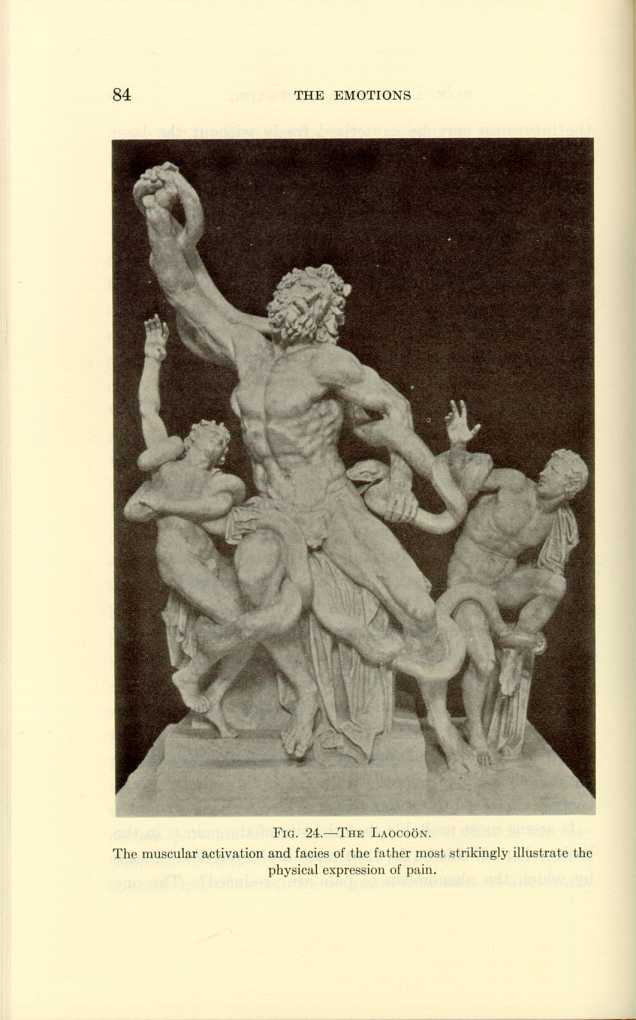
FIG. 24.—THE LAOCOÖN.
The muscular activation and facies of the father most strikingly illustrate the
physical expression of pain.
[Description: Black-and-white photograph of a sculpture depicting a man and
two youths wrestling with a snake.]
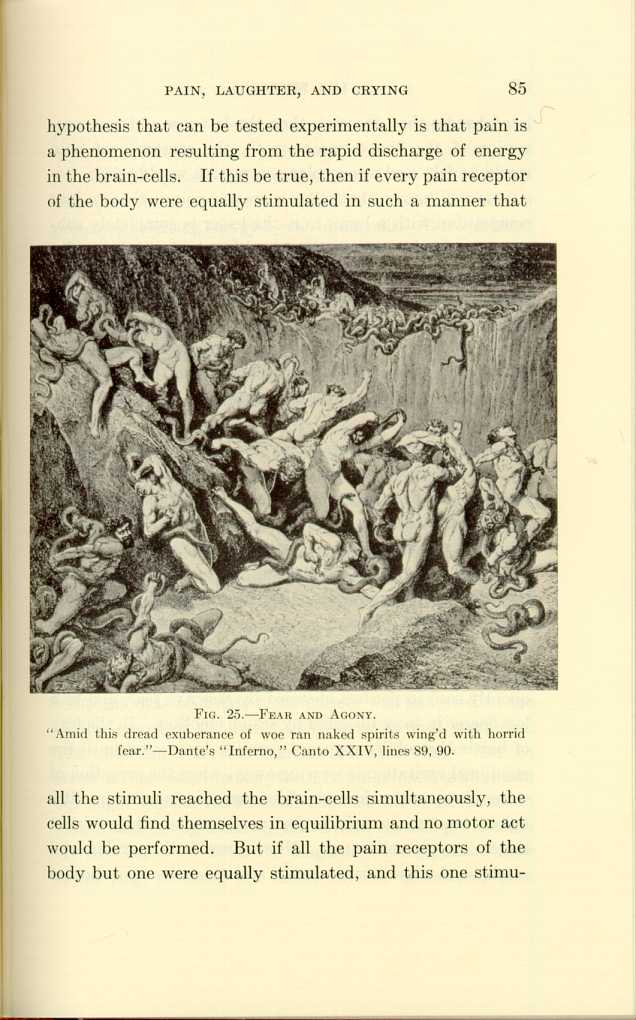
FIG. 25.—FEAR AND AGONY.
"Amid this dread exuberance of woe ran naked spirits wing'd with horrid
fear."—Dante's "Inferno," Canto XXIV, lines 89, 90.
[Description: Black-and-white illustration depicting inhabitants of Hell
being attacked by snakes.]
It is well known that when a greater pain is thrown into competition with a lesser one, the lesser is completely submerged. In this manner the school-boy initiates the novice into the mystery of the painless plucking of hair. The simultaneous, but severe application of the boot to the blindfolded victim takes complete and exclusive possession of the final common path and the hair is painlessly plucked through the triumph of the boot stimulus over the hair stimulus in the struggle for the possession of the final common path.
Another argument in favor of this hypothesis that pain is an accompaniment of the release of energy in the brain-cells is found in the fact that painless stimuli received through the special senses may completely submerge the painful stimuli of physical injury; for although the stimuli to motor action, which are received through the senses of sight, hearing, and smell, cause even more powerful motor action than those caused by physical contact stimuli, yet they are not accompanied by pain. Examples of this triumph of stimulation of the special senses over contact stimulation are frequently seen in persons obsessed by anger or fear, and to a less degree in those obsessed by sexual emotion. In the fury of battle the soldier may not perceive his wound until the emotional excitation is wearing away, when the sensation of warm blood on the skin may first attract his attention. Religious fanatics are said to feel no pain when they subject themselves to self-injury. Now, since both psychic and mechanical stimuli cause motor action by the excitation of
We will now turn to a new viewpoint, a practical as well as a fascinating one, which can best be illustrated by two case histories: A man, seventy-eight years old, whose chief complaint was obstinate constipation, was admitted to the medical ward of the Lakeside Hospital several years ago. The abdomen was but slightly distended; there was no fever, no increased leukocytosis, no muscular rigidity, and but slight general tenderness. He claimed to have lost in weight and strength during the several months previous to his admission. A tentative diagnosis of malignant tumor of the large intestine was made, but free movements were
A child, several years old, was taken ill with some indefinite disease. A number of the ablest medical and surgical consultants of a leading medical center thoroughly and repeatedly investigated the case. Although they could make no definite diagnosis they all agreed that the trouble surely could not be appendicitis because there was neither muscular rigidity nor tenderness. The autopsy showed a gangrenous appendix and general peritonitis.
How can these apparently anomalous cases be explained? These two cases are illustrations of the same principle that underlies the freedom from pain which results from the use of narcotics and anesthetics, the same principle that explains the fact that cholecystitis may occur in the aged without any other local symptoms than the presence of a mass and perhaps very slight tenderness; and that accounts in general for the lack of well-expressed disease phenomena in senility and in infancy. The reason why the aged, the very young, and the subjects of general paresis show but few symptoms of disease is that in senility the brain is deteriorated, while in infancy the brain is so undeveloped that the mechanism of association is inactive, hence pain and tenderness, which are among the oldest of the associations, are wanting. Senility and infancy are by nature normally narcotized. The senile are passing through the twilight into the night; while infants are traversing through the dawn into the day. Hence it is that the diagnosis of injury and disease in the extremes of
For the same reason, when a patient who is seriously ill with a painful disease turns upon the physician a glowing eye and an eager face, and remarks how comfortable he feels, then the end is near. This is a brilliant and fateful clinical mirage.
When one reflects on the vast amount of evidence as to the origin and the purpose of pain, he is forced to conclude that pain is a phenomenon of motor stimulation, and that its principal rôle is the protection of the individual against the gross and the microscopic enemies in his environment. The benefits of pain are especially manifested in the urgent muscular actions by means of which the body moves away from physical injury; obstructions of the hollow viscera are overcome; rest is compelled in the acute infections—the infected points are held rigidly quiet, the muscles of the abdomen are fixed, and harmful peristalsis is arrested in peritonitis; while there is absolutely no pain in the diseases or injuries which affect those regions of the body in which in the course of evolution no pain receptors were placed, or in those diseases in which muscular inhibition or contraction is of no help. In a biologic sense pain is closely associated with the emotional stimuli, for both pain and the emotions incite motor activity for the good of the individual.
The frequent occurrence of post-operative and post-traumatic pain is accounted for by the fact that the operation or the injury has lowered the threshold of the brain-cells to trauma; the brain and not the local sensitive field is the site of the pain. I have found that, by blocking
LAUGHTER AND CRYING
What is laughter? What is its probable origin, its distribution, and its purpose?
Laughter is an involuntary rhythmic contraction of certain respiratory muscles, usually accompanied by certain vocal sounds. It is a motor act of the respiratory apparatus primarily, although if intense it may involve not only the extraordinary muscles of respiration, but most of the muscles of the body. There are many degrees of laughter, from the mere brightening of the eyes, a fleeting smile, tittering and
The formation of tears is sometimes associated with laughter. When integrated with laughter, the nervous system can perform no other function. Crying is closely associated with laughter, and in children especially laughter and crying are readily interchanged.
We postulate that laughter and weeping serve a useful purpose. According to Darwin, only man and monkeys laugh (Fig. 26); other animals exhibit certain types of facial expression accompanying various emotions, but laughter in the sense in which that word is commonly used is probably an attribute of the primates only, although it is probable that many animals find substitutes for laughter.
The proneness of man to laughter is modified by age, sex, training, mental state, health, and by many other factors. Healthy, happy children are especially prone to laughter, while disease, strong emotions, fatigue, and age diminish laughter. Women laugh more than do men. The healthy, happy maturing young woman perhaps laughs most, especially when she is slightly embarrassed.
What causes laughter? Good news, high spirits, tickling, hearing and seeing others laugh; droll stories; flashes of wit; passages of humor; averted injury; threatened breach of the conventions; and numerous other causes might be added. It is obvious that laughter may be produced by diverse influences, many of which are so unlike each other that it would at first sight seem improbable that a single general principle underlies all. Before presenting a hypothesis which harmonizes most of the facts, and which may
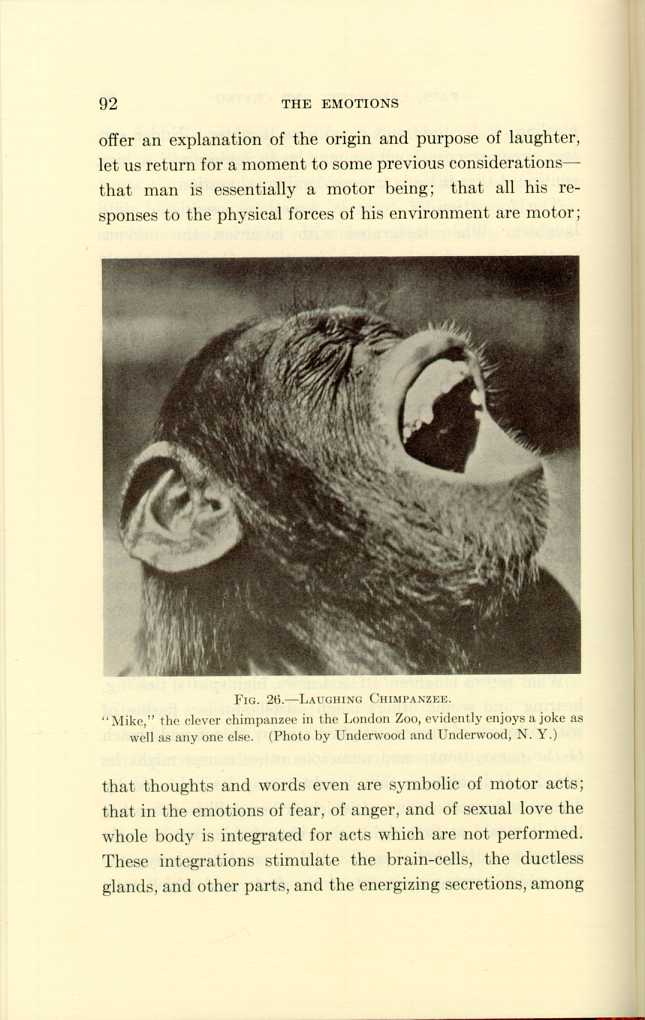
FIG. 26.—LAUGHING CHIMPANZEE.
"Mike," the clever chimpanzee in the London Zoo, evidently enjoys a joke as
well as any one else. (Photo by Underwood and Underwood, N. Y.)
[Description: Black-and-white illustration of chimpanzee with head back,
mouth open, eyes closed.]
In these premises we find our explanation of the origin and purpose of laughter and crying, for since they consist almost wholly of muscular exertion, they serve precisely such clarifying purposes as would be served by the gymnastic exercises of an angry man. As it seems to me, the muscular action of laughter clears the system of the energizing substances which have been mobilized in various parts of the body for the performance of other actions (Figs. 27 to 29). If this be true, the first question that presents itself is, Why
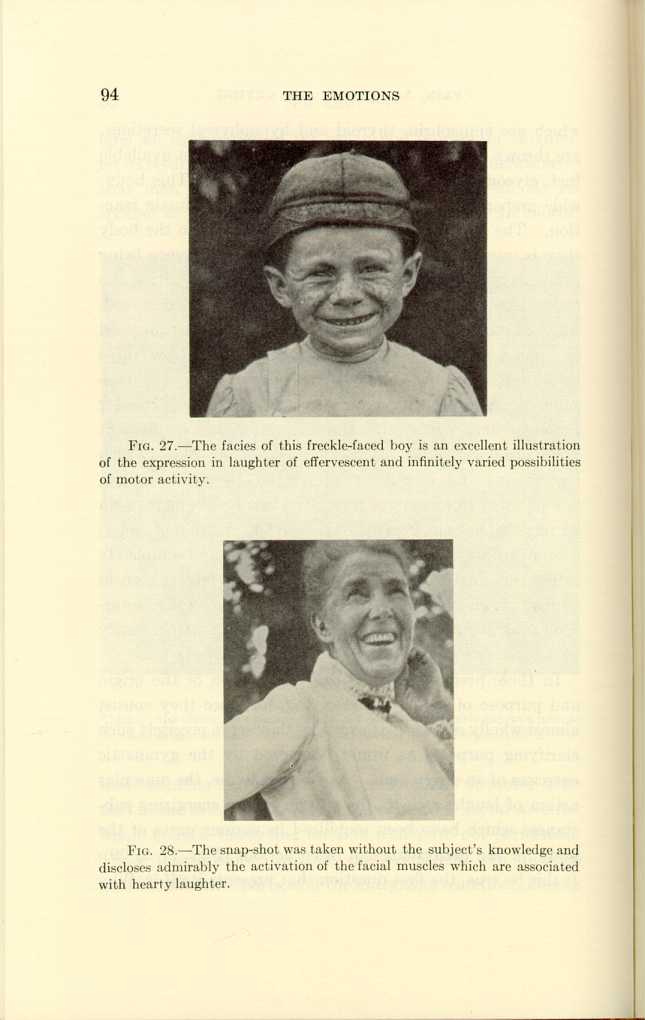
FIG. 27.—The facies of this freckle-faced boy is an excellent illustration of the expression in laughter of effervescent and infinitely varied possibilities of motor activity.
[Description: Black-and-white photograph of a boy smiling.]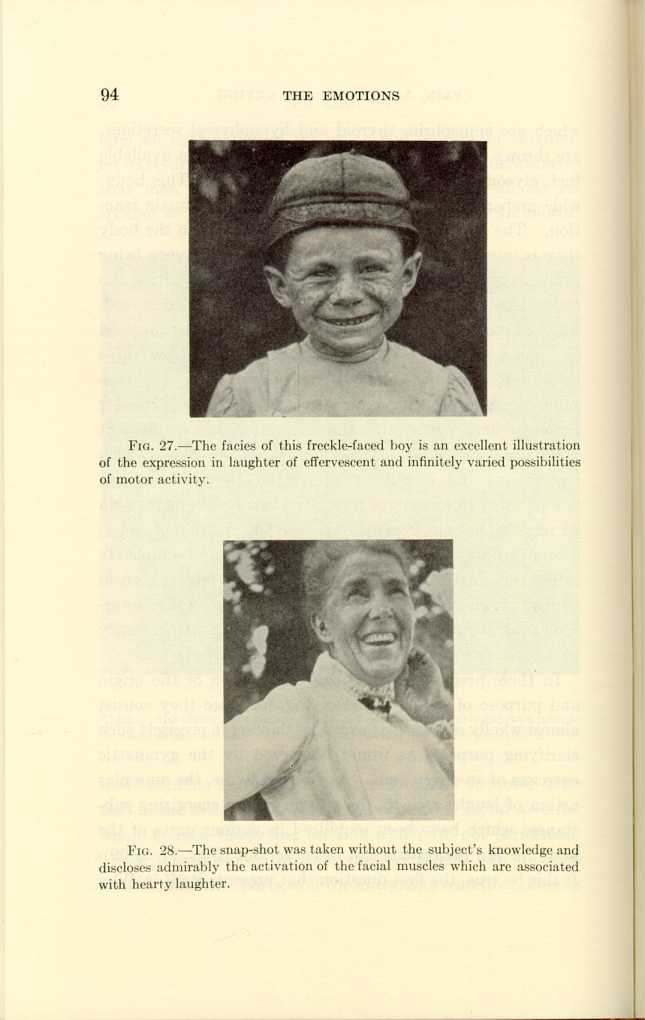
FIG. 28.—The snap-shot was taken without the subject's knowledge and discloses admirably the activation of the facial muscles which are associated with hearty laughter.
[Description: Black-and-white photograph of a woman smiling or laughing.]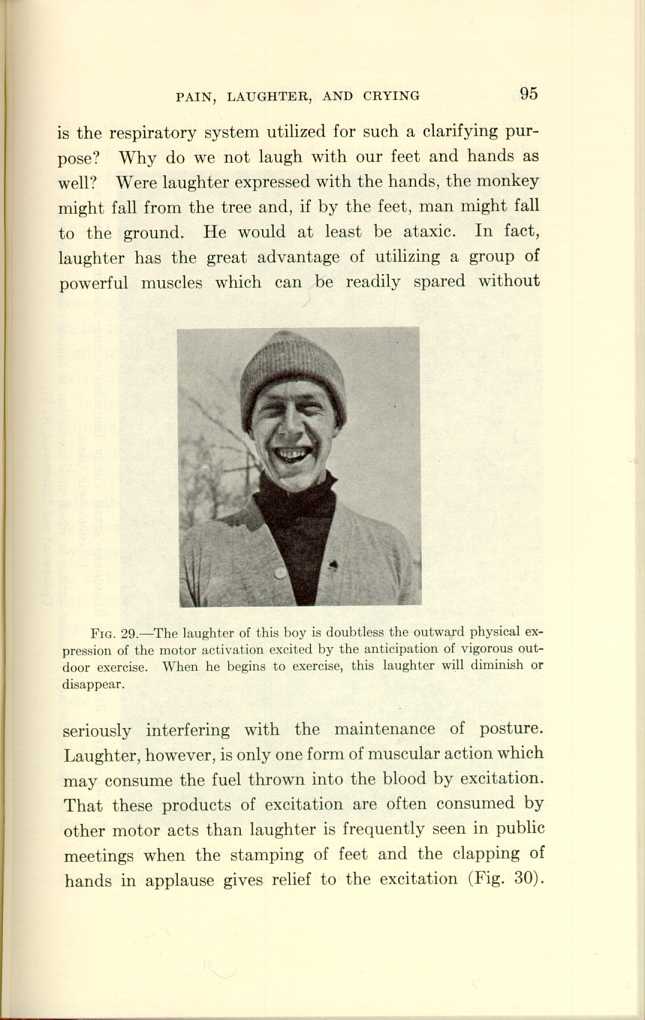
FIG. 29.—The laughter of this boy is doubtless the outward physical expression of the motor activation excited by the anticipation of vigorous outdoor exercise. When he begins to exercise, this laughter will diminish or disappear.
[Description: Black-and-white photograph of a young man smiling or laughing.]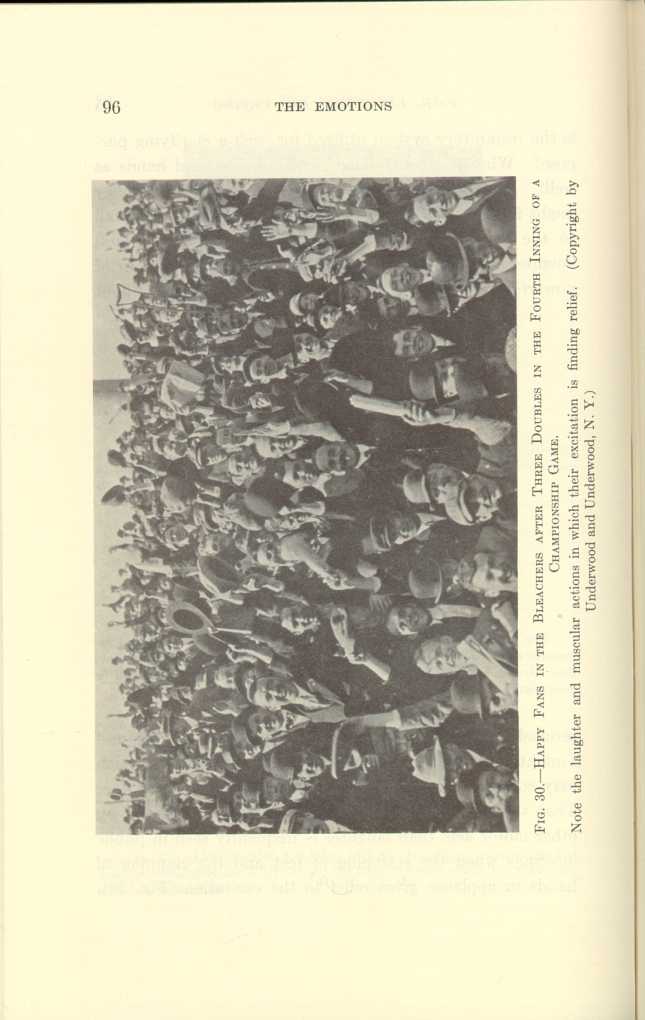
FIG. 30.—Happy Fans in the Bleachers after Three Doubles in the Fourth Inning of a Championship Game.[a]
[Description: Black-and-white photograph of a crowd of men cheering.]Let us test this hypothesis by some practical examples. The first is an incident that accidentally occurred in our laboratory during experiments on fear which were performed as follows: A keen, snappy fox terrier was completely muzzled by winding a broad strip of adhesive plaster around his jaw so as to include all but the nostrils. When this aggressive little terrier and the rabbit found themselves in close quarters each animal became completely governed by instinct; the rabbit crouched in fear, while the terrier, with all the ancestral assurance of seizing his prey, rushed, upon the rabbit, his muzzle always glancing off and his attack ending in awkward failure.
This experiment was repeated many times and each time provoked the serious-minded scientific visitors who witnessed it to laughter. Why? Because the spectacle of a savage little terrier rushing upon an innocent rabbit as if to mangle it integrated the body of the onlooker with a strong desire to exert muscular action to prevent the cruelty. This
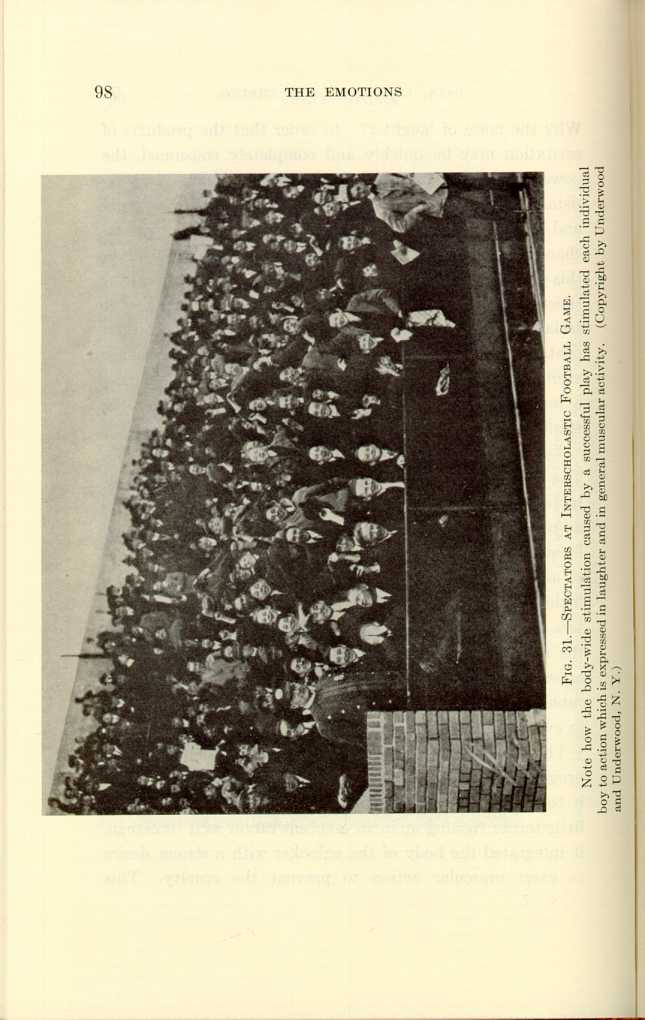
FIG. 31.—Spectators at Interscholastic Football Game.[b]
[Description: Black-and-white photograph of a crowd of boys cheering.]A common example of the same nature is that encountered on the street when a pedestrian slips on a banana peel and, just as he is about to tumble, recovers his equilibrium. The onlookers secure relief from the integration to run to his rescue by laughing. On the other hand, should the same pedestrian fall and fracture his skull the motor integration of the onlookers would be consumed by rendering physical assistance—hence there would be no laughter. In children almost any unexpected phenomenon, such as a sudden "booing" from behind a door, is attended by laughter, and in like manner the kinetic reaction produced by the innumerable threats of danger which are suddenly averted, a breach of the conventions, a sudden relief from acute nervous tension; a surprise—indeed, any excitant to which there is no predetermined method of giving a physical response—may be neutralized by the excitation of the mechanism of laughter.
In the same way the laughter excited by jokes may be explained. An analysis of a joke shows that it is composed of two parts—the first, in which is presented a subject that acts as a stimulus to action, and the second, in which the story turns suddenly so that the stimulus to action is unexpectedly
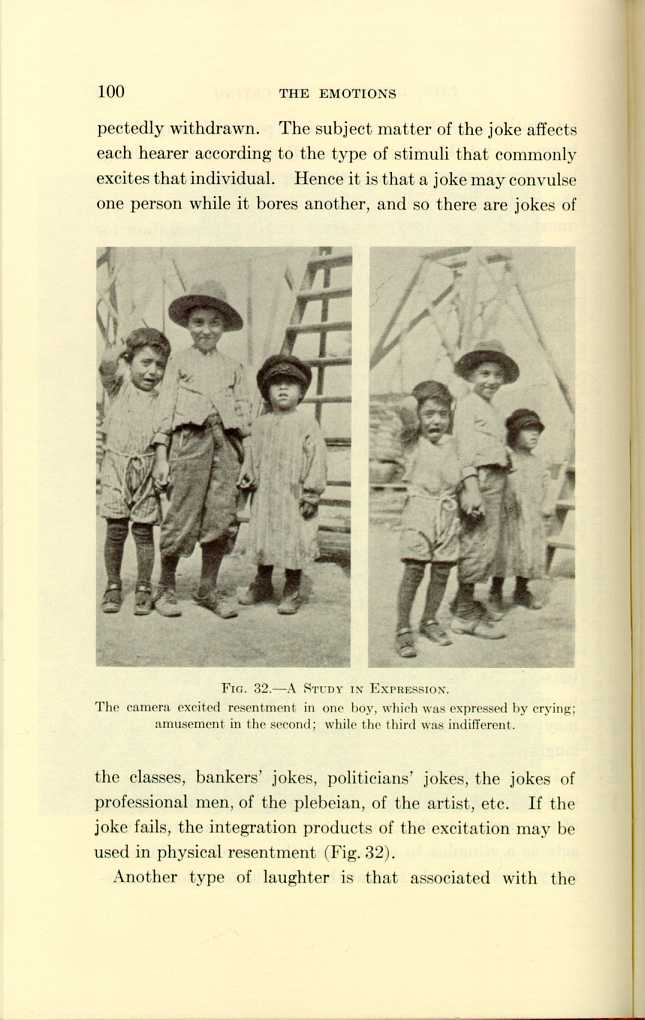
FIG. 32.—A STUDY IN EXPRESSION.
The camera excited resentment in one boy, which was expressed by crying;
amusement in the second, while the third was indifferent.
[Description: Black-and-white photograph of three boys: one crying, one
smiling, one expressionless.]
Another type of laughter is that associated with the
Anger, fear, and grief are also strong excitants and, therefore,
It is on this hypothesis that the origin and the purpose of laughter and crying may be understood. Even a superficial analysis of the phenomena of both laughter and crying show them to be without any external motor purpose; the respiratory mechanism is intermittently stimulated and inhibited; and the shoulder and arm muscles, indeed, many muscles of the trunk and the extremities are, as far as any external design is concerned, purposelessly contracted and released until the kinetic energy mobilized by excitation is utilized. During this time the facial expression gives the index to the mental state.
Crying, like laughter, is always preceded by a stimulation to some motor action which may or may not be performed (Figs. 33 and 34). If a mother is anxiously watching the course of a serious illness of her child and if, in caring for it, she is stimulated to the utmost to perform motor acts, she will continue in a state of motor tenseness until the child recovers or dies. If relief is sudden, as in the crisis of pneumonia, and the mother is not exhausted, she will easily laugh if tired, she may cry. If death occurs, the stimulus to motor acts is suddenly withdrawn and she then cries aloud, and performs many motor acts as a result of the intense stimulation to motor activity which is no longer needed in the physical care of her child. With this clue we can find the
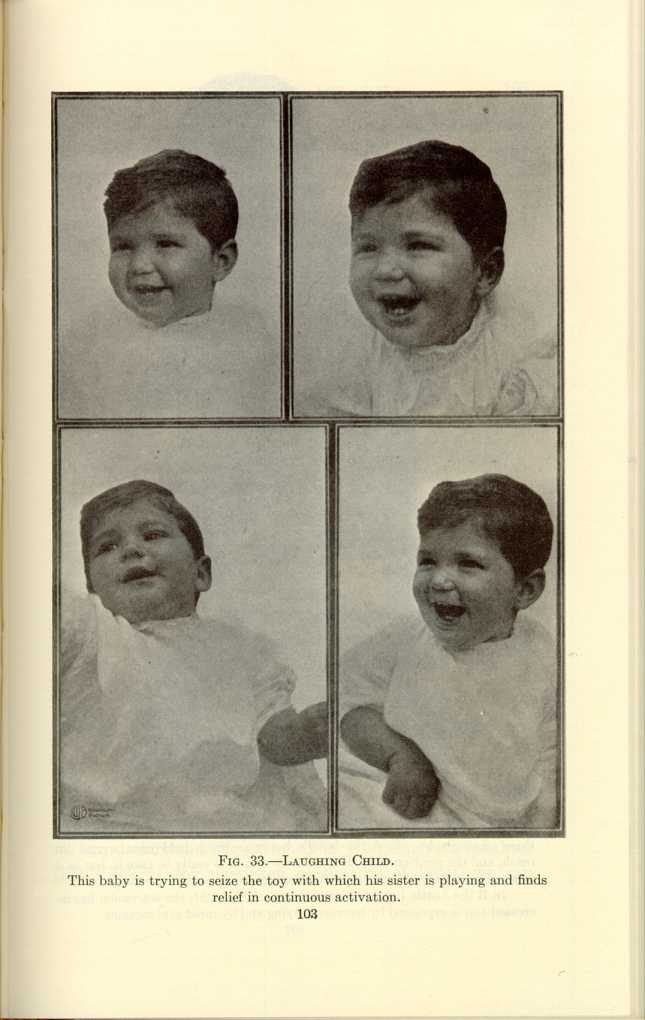
FIG. 33.—LAUGHING CHILD.[c]
[Description: Black-and-white photographs in four parts showing a baby laughing.]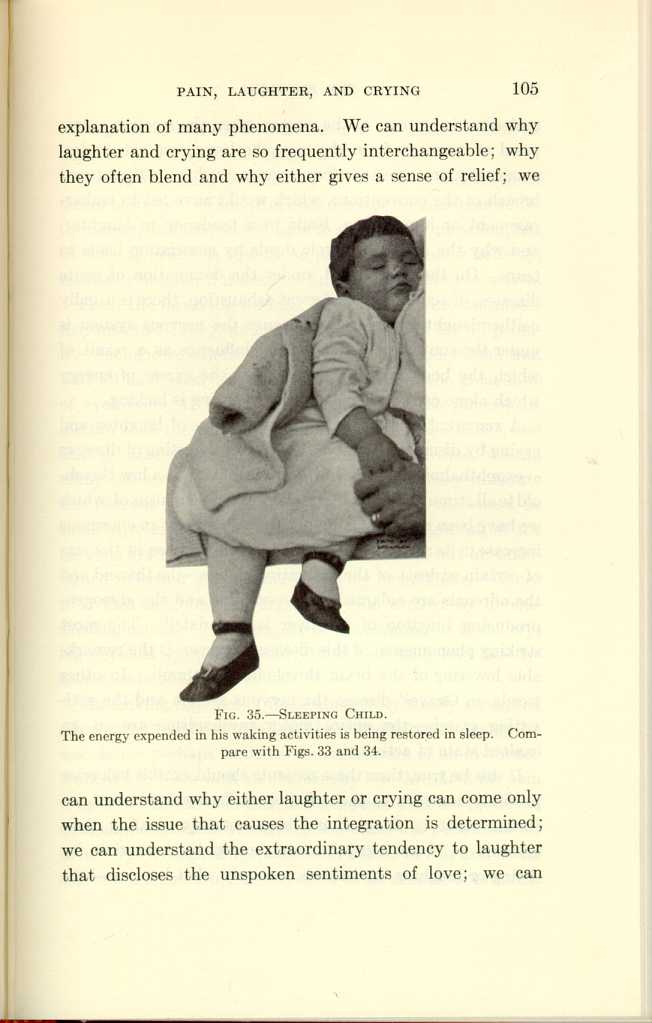
FIG. 35.—SLEEPING CHILD.[e]
[Description: Black-and-white photograph of baby sleeping on mother's lap.]A remarkable study of the modification of laughter and crying by disease is found in that most interesting of diseases—exophthalmic goiter. In this disease there is a low threshold to all stimuli. That the very motor mechanism of which we have been speaking is involved, is shown by an enormous increase in its activity. There is also an increase in the size of certain at least of the activating glands—the thyroid and the adrenals are enlarged and overactive and the glycogen-producing function of the liver is stimulated. The most striking phenomenon of this disease, however, is the remarkable lowering of the brain thresholds to stimuli. In other words, in Graves' disease the nervous system and the activating glands—the entire motor mechanism—are in an exalted state of activity.
If this be true, then these patients should exhibit behavior precisely contrary to that of those suffering from acute infection, that is, they should be constantly clearing their systems of these superabundant energizing materials by crying or laughing, and this is precisely what happens—the
We have already interpreted pain as a phenomenon of motor activity. When pain does not lead to muscular activity it therefore frequently leads to crying or to moaning, just as tickling, which is equally an incentive to motor activity, results in laughter if it does not find full expression in action.
From the foregoing we infer that pain, the intense motor response to tickling, and emotional excitation are all primitive biologic reactions for the good of the individual, and that all have their origin in the operation of the great laws of evolution. If to this inference we add the physiologic dictum that the nervous system always acts as a whole, and that it can respond to but one stimulus at a time, we can easily understand that while diverse causes may integrate the nervous system for a specific action, if the cause be suddenly removed, then the result of the integration of the nervous system may be, not a specific action, but an undesigned muscular action, such as crying or laughter. Hence it is that laughter and crying may be evoked by diverse exciting causes. The intensity of the laughter or of the crying depends upon the intensity of the stimulus and the dynamic state of the individual.
The linking together of these apparently widely separated phenomena by the simple law of the discharge of energy by association perhaps explains the association of an abnormal tendency to tears with an abnormally low threshold for pain (Fig. 36). In the neurasthenic, tears and pain are produced with abnormal facility. Hence it is that, if a patient about to undergo a surgical operation is in a state of fear and dread before the operation, the threshold to all stimuli is lowered,
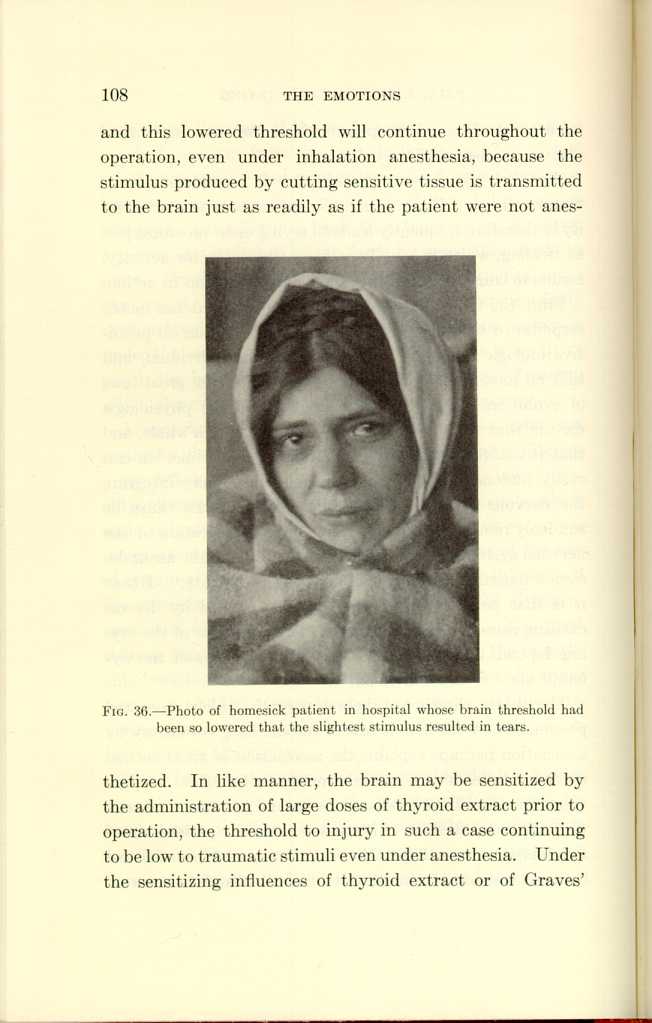
FIG. 36.—Photo of homesick patient in hospital whose brain threshold had been so lowered that the slightest stimulus resulted in tears.
[Description: Black-and-white photograph of a woman with a sad facial expression.]I hope that even this admittedly crude and imperfect consideration of this subject will suggest the possibility of establishing a practical viewpoint as to the origin and purpose of pain, of tickling, and of such expressions of emotion as laughter and crying, and that it may help us to understand their significance in health and in disease.
Address delivered before the John Ashhurst, Jr.. Surgical Society of the University of Pennsylvania, May 3, 1912.
Note the laughter and muscular actions in which their excitation is finding relief. (Copyright by Underwood and Underwood, N.Y.)
Note how the body-wide stimulation caused by a successful play has stimulated each individual boy to action which is expressed in laughter and in general muscular activity.
This baby is trying to seize the toy with which his sister is playing and finds relief in continuous activation.
That crying is the result of stimulation to motor
activity is well shown by these photographs. In A the baby's bottle is
being held just beyond his reach, and the position of his hands shows
that he is ready to take it, but as it is not given to him, his
activation finds expression in moderate crying.
In B the bottle has been carried out of his sight, the activation has
increased and is expressed by increased crying and by rapid arm
motions.
| The Origin and Nature of the Emotions: Miscellaneous Papers | ||
